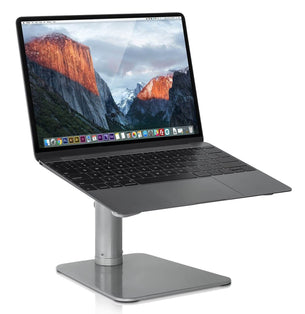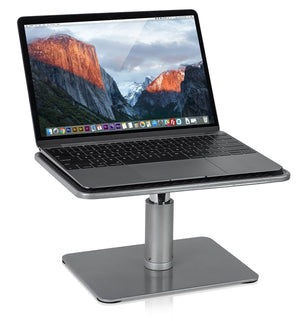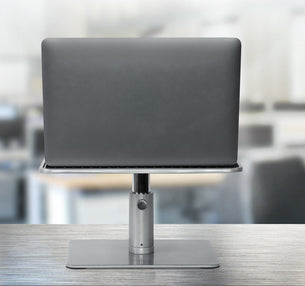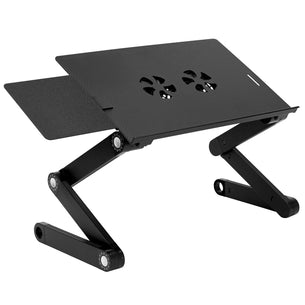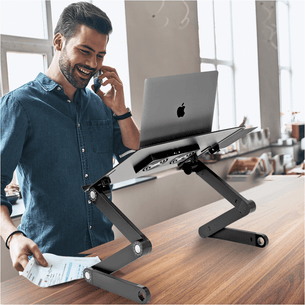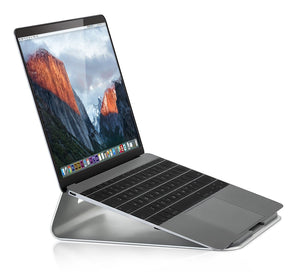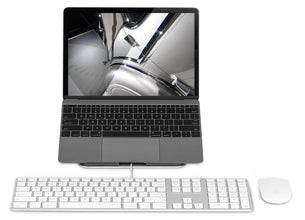In today’s fast-paced digital world, laptops are essential tools for work, entertainment, and communication. However, extended use of a laptop can often lead to discomfort, poor posture, and even long-term health issues. This is where a laptop stand becomes a game-changer. Investing in the right desktop laptop stand, ergonomic laptop stand, or laptop stand for desk setups can transform your workspace and boost your productivity whether you’re working from home, at the office, or on the go. If you're looking to improve your workstation setup, a device riser can provide better posture and improve comfort.
In this comprehensive guide, we'll explore everything you need to know about laptop stands, including their benefits, types, features to look for, and recommendations for different use cases. We’ll also answer frequently asked questions to help you make an informed decision. To better understand the ergonomics of laptop use, read our in-depth guide on Laptop Ergonomics.
Why You Need a Laptop Stand
1. Ergonomic Benefits
One of the most significant advantages of using a laptop holder is its ability to promote healthier ergonomics. Laptops, with their compact design, often force users into a hunched-over position, causing a range of musculoskeletal issues. Over time, this can lead to not only neck pain, back pain, and eye strain but also more serious conditions like cervical spine pain, lower back discomfort, and digital eye strain. A workspace stand helps address these issues by elevating your device to eye level, promoting a more natural and aligned posture, and reducing strain on your neck and shoulders. This reduces the risk of chronic pain and improves your long-term comfort and mobility. Want to learn more about how ergonomics affects your health? Read our in-depth guide on Laptop Ergonomics.
2. Enhanced Productivity
A well-organized workstation reduces distractions and promotes a structured workflow. Many professionals who use a standing laptop stand report increased efficiency as it allows them to maintain a comfortable viewing angle, reducing eye strain and physical discomfort. Additionally, a laptop stand with cooling can prevent performance slowdowns due to overheating, ensuring that your laptop runs smoothly throughout the workday. A clutter-free desk can also improve mental clarity and focus, making it easier to stay productive. By improving your physical comfort you are also improving your mental performance.
3. Improved Cooling and Performance
Laptops often overheat during prolonged use, especially when placed on soft surfaces like beds or couches. Overheating can lead to performance throttling, causing the processor to slow down to prevent damage. A laptop stand for desk is designed to improve airflow, preventing overheating and maintaining optimal performance. Some laptop stands come with built-in fans or passive ventilation to enhance cooling further, making them an excellent choice for users involved in gaming, video editing, or software development. If you are working on resource intensive tasks, a desk riser can help you maintain an optimum operating temperature.
Types of Laptop Stands
1. Risers
Risers are simple stands designed to lift a laptop off the desk to improve screen height and airflow. They come in different materials like aluminum, plastic, and wood. Aluminum risers tend to be lightweight and durable, while wooden risers add a touch of elegance to a workspace. If you are looking for a low-cost, simple solution, risers are a great option.
2. Adjustable Laptop Stands
These offer height and angle adjustments, making them perfect for those who need flexibility in their workstation setup. Common adjustment types include height extension and tilt functionality, which help users achieve an ergonomic viewing angle that suits their body type. If you share a workspace or require flexibility in your set up, these stands will give you the adaptability you need.
3. Folding/Portable Laptop Stands
Designed for travel, these portable laptop stands are lightweight and collapsible. Many models are made from aluminum, ensuring both durability and minimal weight. They are perfect for professionals who work in multiple locations, or for those that do not always work at their desks.
4. Cooling Laptop Stands
Equipped with built-in fans or ventilation systems, these cooling laptop stands help prevent overheating. Many cooling stands come with USB-powered fans that actively push air beneath the laptop, making them ideal for users working with high-performance applications. If your laptop regularly overheats, a cooling desk riser could save you a lot of potential frustration.
5. Standing Desk Converters
These allow users to transform their existing desk into a standing workstation, offering both sitting and standing options for improved health and productivity. Some models include additional keyboard trays to create a full ergonomic setup. Standing desk converters are ideal for individuals who spend long hours at their desks and want to reduce sedentary behavior. Studies have shown that alternating between sitting and standing throughout the day can help lower the risk of cardiovascular disease, obesity, and back pain. Many standing desk converters feature gas spring or electric lift mechanisms, allowing users to switch positions effortlessly. They also come in a variety of designs, including compact options for small workspaces and larger models that accommodate multiple monitors. Some even include built-in cable management to keep wires organized and out of the way. These devices allow you to incorporate movement into your work day with minimal disruption.
Conclusion
A laptop stand is more than just a workspace accessory; it’s a productivity and health tool. Whether you’re looking for a laptop stand for desk use, a desktop laptop stand, an ergonomic laptop stand, or a portable laptop stand, there’s a solution to fit your needs. By investing in a laptop holder, you are investing in a healthier and more productive way to work.
If you travel frequently, a folding portable laptop stand may be your best option for lightweight convenience. For those who experience overheating, a cooling device riser with built-in fans will help maintain peak performance. If you require a more permanent, ergonomic setup, consider a standing desk converter to alternate between sitting and standing for maximum health benefits. Choosing the best fit for your needs should be determined by your own working habits, and your level of activity during the day. For the most ergonomic experience, you can also seek a keyboard tray as part of your work setup.
For more recommendations, visit our laptop stand collection and read the reviews on our products or check out our latest selection of standing laptop stands and cooling laptop stands to find the best fit for your workspace. Your back, neck, and productivity will thank you! If you need more information on how to improve your desk ergonomics, consider reading our guide: How To Ergonomically Use A Laptop.
Frequently Asked Questions (FAQ)
1. Are laptop stands good for ergonomics?
Yes, laptop stands are great for ergonomics. They elevate your screen to eye level, reducing neck strain and promoting better posture.
2. What is the best laptop stand for working from home?
The best laptop stand for working from home depends on your needs. A desktop laptop stand is best if you have a permanent workspace, but for more flexibility, consider an adjustable laptop stand.
3. How does a cooling laptop stand help performance?
A cooling laptop stand helps performance by preventing overheating. This will prevent throttling, and help your device to operate at optimum levels.
4. Is a standing desk converter better than a laptop stand?
A standing desk converter is a broader solution, providing both sitting and standing options. A simple laptop stand is great for those looking for a low-cost way to improve their posture.
5. What features should I look for in a laptop stand?
When choosing a laptop stand, look for adjustable height, a sturdy build, and features that suit your needs (e.g., cooling fans, portability). This will help you find the best fit for your own specific needs.
For more information on how to improve your workstation setup, visit our guide on laptop ergonomics, or browse our wide range of laptop stands.


